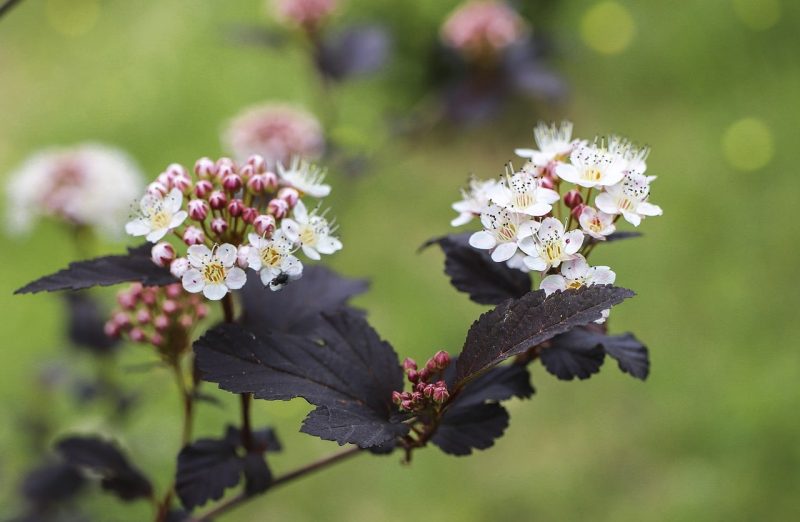If you have ever asked yourself the question, “How do you treat powdery mildew on ninebark,” then you are not alone.
No matter how captivating they are, ninebark can go from 100 to 0 really quickly when powdery mildew hits them. Regardless of the cultivar, ninebark can bring that pop of color that you desire for your garden.

If you have them in your space and notice that white fungi are starting to accumulate, then you have to treat the disease as soon as possible. You can refer to that not-so-friendly fungus as powdery mildew.
Tips in Treating Powdery Mildew
Most gardeners usually get rid of powdery mildew for aesthetic purposes. After all, they are not necessarily dangerous, or at least when you don’t leave them untreated. Since they are parasitic, they will leech your ninebarks’ nutrients and affect their bloom.
Tip #1: Location and temperature matters
During late spring to early summer, powdery mildew starts to grow. Its ideal conditions are humid places with a moderate or cool temperature. If you place your ninebarks on mildew-prone areas with low lighting, they will most likely contract the disease.
Therefore, it is best to avoid placing your plants in shady locations and expose them to just enough light instead. Also, make sure that they are spaced apart from each other for air circulation purposes. Don’t forget to pay attention to the drainage of the water too.
Tip #2: Ensure that they get the nutrients they need
As stated before, high humidity can cause an increase in the growth of powdery mildew. Therefore, keep your Ninebarks hydrated and focus on the surrounding ground instead of the leaves. However, make sure not to overwater them.
When it comes to boosting the soil’s nutrients, composts are recommended, not fertilizers. So avoid them, especially the ones with high nitrogen levels. Like with watering, avoid overdoing it as new growth tends to be vulnerable to diseases.
Tip #3: Make use of environmentally friendly treatments
Whether there are only signs or already developed powdery mildew, you can make use of fungicide treatments. You are recommended to choose the organic types and to spray them to your ninebarks every 10 to 14 days.
One effective solution for preventing powdery mildew is baking soda. All you have to do is combine one tablespoon with one-half teaspoon of liquid soap and a gallon of water.
Likewise, you can use mouthwash or milk separately by mixing them with one on every three parts of water. However, make sure to use the former with caution as that chemical can be fatal to new growth, while the latter is not, it’s not as effective.
Does Greenhouse Gardening Make Perfect Sense?
Anyone who wants to take their gardening experience to higher heights should seriously consider greenhouse gardening. Greens aficionados can attest that this is a far better alternative to traditional outdoor gardening.
Aside from providing your plants with the protection that they need against the elements, pests, and other factors that can easily put all of your gardening efforts to waste, a greenhouse also provides you countless opportunities to grow any type of plant and reap your ideal harvest. If you want to take a closer look at the benefits of having your own greenhouse, regardless if it’s a mini greenhouse, a hobby greenhouse, or a semi pro greenhouse, check this out:
It protects your plants from pests and critters
The last thing you want is to see a deer or a raccoon happily feasting on your berries, melons, and peas. With a greenhouse to shield your tender plants from these predators, you won’t have to lose sleep worrying about their safety.
Furthermore, unlike traditional outdoor gardeners who face the constant threat of destructive bugs day in and day out, you can rest easy knowing that your greenhouse acts as an effective barrier between your botanical oasis and these harmful pests.
It keeps your plants safe from bad weather conditions
Since a greenhouse is an enclosed structure, there’s no need for you to worry about your plants’ safety in the event of harsh weather conditions. This eliminates the need for coming up with emergency preparations that take a lot of time and effort on your end. There’s nothing like a greenhouse to keep your plants safe whenever there’s a thunderstorm or a blizzard.
You can grow any type of plant
One of the best things about greenhouse gardening is the fact that you can easily grow any type of plant that’s not native to your area. Since a greenhouse is an enclosed space, it allows you to easily manipulate the conditions of your plants’ growing environment such as the temperature and humidity. You can finally enjoy cultivating your favorite tropical and exotic plants right in your own backyard!
Conclusion: How Do You Treat Powdery Mildew On Ninebark?
The answer is to try to minimize the damage as much as possible. If the fungi persist after all the treatments mentioned above, the best thing you can do is remove the infected ninebarks.
This removal is necessary to prevent them from infecting the nearby plants. Make sure to also put them in a bag so that the spores won’t spread. Remove the leaves and debris around the infected plants that you have removed, then replace the mulch to avoid further contamination.
Remember, if you want to know the answer to the question of how do you treat powdery mildew on ninebark, then keep the other ninebarks maintained by removing the infected parts and tending to their needs.
